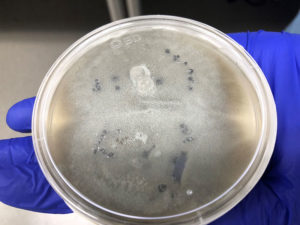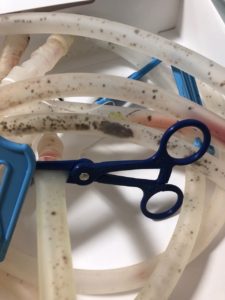Centrifugal Fungus: Black Mold Emerges from the Tube
Submitted by: Robert Rolfe Jr, Becky Smith, Jacob Klapper, John Perfect, Julia Messina
Institution: Duke University

History:
A 67 year-old man originally from Colombia with end-stage interstitial lung disease was admitted to Duke University Medical Center (DUMC) for bilateral orthotopic lung transplant (BOLT). His BOLT surgery was complicated by hemorrhage requiring multiple units of red blood cells, plasma, platelets, and cryoprecipitate. Post-operatively, his chest was left open, and he was placed on veno-venous extracorporeal membrane oxygenation (ECMO). Per hospital protocol, the patient was placed on inhaled amphotericin B lipid complex prophylaxis as well as prophylactic intravenous (IV) fluconazole with plans to continue through index hospitalization. However, as he had worsening liver function, his fluconazole was switched to micafungin on post-operative day two. On this same day, the patient was taken back to the operating room (OR) for right middle and lingula lobectomies, and his chest remained open. On post-operative day five, he underwent tracheostomy. On post-operative day seven, the patient’s chest was finally closed.
The patient remained critically ill in the ICU with renal failure on continuous renal replacement therapy and had also developed a pneumoperitoneum requiring return to the OR. On post-operative day 53, black mold was found growing from the patient’s chest tubes, bilaterally (Figure 1). Multiple colonies studded the tubes, and their growth seemed to have originated from the patient, with outward growth. At this point, he had four chest tubes, all of which had been present since his initial transplant.
The patient was taken to the OR on post-operative day 54 for washout of the right chest and replacement of chest tubes through a video assisted thoracic surgery (VATS). Mold was encountered throughout his right pleural space and along the pericardium. None was noted along his original clamshell surgical incision from his BOLT, and this site was irrigated with 3.5L saline mixed with chlorhexidine, and chest tubes were replaced. He was taken again for washout of the left pleural space on post-operative day 56, and no mold was seen.
 Physical Examination:
Physical Examination:
Physical Exam from date of invasive mold infection diagnosis:
Temperature 35.7 degrees Celsius, Heart rate 65 beats per minute, Blood pressure: 119/56, Respiratory rate: 24, Oxygen saturation: 100% on ventilator FiO2 50%, Positive end expiratory pressure 8cm water
- General: in no acute distress, on continuous veno-venous hemodialysis
- Eyes: anicteric sclera
- Neck: tracheostomy in place
- Head, ears, nose, throat: normocephalic, atraumatic
- Cardiovascular: regular rhythm, no murmurs, rubs or gallops
- Respiratory: bronchial breath sounds appreciated bilaterally from anterior. Clamshell incision with staples in place appearing dusky along wound margins. Two chest tubes on each side (total of four) with black mold colonies studding the tubing
- Abdomen: has gastric and jejunal tube. Soft. Abdominal incision without drainage/ erythema
- Extremities: warm, well perfused, pitting edema in bilateral lower extremities
- Skin: no rashes or lesions
- Neuro: able to track with eyes towards voice but not able to follow commands.
Laboratory Examination:
- White blood cell: 20.7 (3.2-9.8 x10^9/L)
- Hemoglobin 8.3 (13.7-17.3 g/dL)
- Platelet count 79 (150-450 x10^9/L)
- Creatinine 0.4 (0.6-1.3mg/dL)
- Aspartate aminotransferase 111 (15-41 U/L)
- Alanine aminotransferase 50 (17-63 U/L)
- Total bilirubin 6.6 (0.4-1.5 mg/dL)
- Alkaline Phosphatase 77 (24-110 U/L)
Question 1: What are probable/possible diagnoses?
Microbiology/Diagnostic Tests Performed:
Right and Left pleural fungal cultures: Curvularia species (figure 2)
Blood cultures: negative
Fungal blood culture: negative
Bronchoalveolar lavage cultures: negative
Cytomegalovirus Polymerase Chain Reaction: undetected
| Results of Antifungal Susceptibility Testing | ||
| Drugs: | Minimal Inhibitory Concentration (MIC [mcg/mL]) | Interpretation |
|---|---|---|
| Amphotericin B | 0.06 | No Established Breakpoints |
| Micafungin | 0.06 | No Established Breakpoints |
| Posaconazole | 0.125 | No Established Breakpoints |
| Voriconazole | 8 | No Established Breakpoints |
| Isavuconazole | 4 | No Established Breakpoints |
